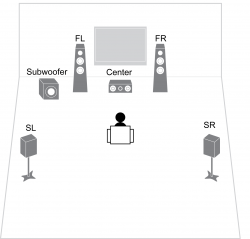What’s So Good About Dolby Atmos® and DTS:X™?
You don’t have to be a nerd to be blown away by awesome sound.
If you’re reading this post, you’re probably into home audio and care about sound quality in your home entertainment system. You may love movies and have a home theater system. You may love being immersed in 7.1-channel surround sound and feeling like you’re in the middle of the action. If this sounds like you, you’ll want to know about two features in 7-channel AV receivers and high-end sound bars: Dolby Atmos and DTS:X.
A brief look at the evolution of home theater sound will give some context to these new features. When you first heard 5.1-channel surround sound, you were probably amazed at how much fuller and more lifelike it sounded compared to 2-channel stereo sound.

5.1-Channel Surround Sound
By the way, 5.1 means there are five speakers at ear level – front left, center, front right, surround left and surround right. The .1 indicates one subwoofer.

7.1-Channel Surround Sound
Then came remarkably expansive 7.1-channel surround sound, which added two ear-level speakers behind the listener: surround back left and surround back right. We were one step closer to having that movie theater experience in our living rooms. The sound was engrossing, but we were still trapped in a two-dimensional world.

Object-Based Audio
Well, movie fans, the third dimension has arrived! Get ready to have your mind blown by object-based audio. If you’ve seen Captain America: Civil War or Star Wars: Episode VII – The Force Awakens in a Dolby Atmos-enabled theater, you’ve experienced this amazing technology. That same thrilling three-dimensional sound technology is available for your home!What makes object-based audio so much better than surround sound? In multichannel audio, sounds are associated with speakers. Sounds coming from in front of you come out of the front speakers, and as they move around you, they move from speaker to speaker. In object-based audio, each sound is an object that can be programmed by sound engineers to move independently. For example, the data that describes each object and how it is moving is sent in the soundtrack or bitstream to your Dolby Atmos or DTS:X-capable AV receiver. Based on where your speakers are in the room, your AV receiver determines which combinations of speakers to use to create the sound. Two companies are pioneering this revolutionary technology.
Dolby Atmos
Dolby Laboratories, Inc. released its object-based audio technology, Dolby Atmos, in movie theaters in 2012, coinciding with the release of the Pixar movie Brave. The movie is hailed for its many technical innovations, including incredibly immersive 3D sound. Dolby Atmos accomplishes this effect with up to 128 individually programmed sound objects moving independently in 3D space. When you play a soundtrack or bitstream, Dolby Atmos maps the sound objects to the available speaker configuration. Dolby Atmos recommends adding at least two and ideally four overhead speakers to a surround sound setup for a 7.1.4-channel system. The .4 indicates the number of overhead speakers, which can be actual ceiling speakers or upward-firing Dolby Atmos-enabled speakers that sit at ear level. Even if you only have a 5.1-channel system, Dolby Atmos content will play back in the best way for your system to provide the optimal listening experience.
DTS:X
DTS announced its object-based audio technology, DTS:X, in 2015. You may have seen the movies Independence Day or London Has Fallen, which feature DTS:X. One of the main differences from Dolby Atmos for home users is that DTS:X does not require any specific speaker configuration. It adapts to the number and location of the speakers you already have. For you technology geeks out there, DTS:X also accommodates an unlimited number of sound objects, as opposed to Dolby Atmos’ 128-object limit.
Best of Both Worlds
Luckily, you don’t have to choose between these two technologies, because Yamaha offers AV receivers that feature both Dolby Atmos and DTS:X. If you plan on enjoying movies in both technologies, try to follow the Dolby Atmos specifications for setting up your home theater. Then pick a good seat and settle in for a phenomenal home entertainment experience!















